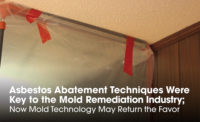Asbestos Remediation Reminders
Global Asbestos Awareness Week

April 1-8, 2018 is designated as Global Asbestos Awareness Week, a time to reflect, educate, and raise awareness about the threats exposure to asbestos carries. In the restoration and remodeling fields, the presence of asbestos can greatly complicate projects. According to the World Health Organization, about 125 million people globally are exposed to asbestos in the workplace, which can lead to serious health issues. Adherence to proper protocol is crucial in not only protecting abatement professionals, but safeguarding the environment and the community from exposure.
Asbestos is a naturally-occurring silicate mineral that has been mined for centuries. Utilized for its strong fire resistant properties, as well as its natural durability and cost effectiveness, the material was used extensively in modern construction. Today, asbestos can be found in most homes built prior to 1980, where it was common practice to fortify building materials with the substance. Thousands of different asbestos-containing products were created throughout the 20th century, but the mineral can most commonly be found in insulation, flooring, roofing, and some electrical applications in the home. While asbestos use has dropped steadily throughout the United States, there still isn’t a full ban in place.
A Rare, Aggressive Cancer
Exposure to asbestos can result in serious illness, most notably mesothelioma cancer. The disease generally manifests in the lining of the lungs, but can also occur in the lining of the abdomen or heart. Mesothelioma occurs after direct exposure to airborne asbestos particles, which are inhaled and then settle in the body. After a latency period of anywhere from 10-50 years, the cancer begins to cause symptoms, including chest tightness, chronic cough, and fluid buildup in the lungs. Due to the commonality of the symptoms, mesothelioma is often misdiagnosed at first and eventually realized in its later stages. Prognosis is poor for the illness and most patients face a life expectancy of only 12-21 months after diagnosis. There is currently no cure for mesothelioma.
Why Homeowners Need Skilled, Trained Remediation Contractors
For the average homeowner, there is no way to DIY test for asbestos and it’s actually strongly discouraged. While it’s fairly safe to assume homes built before 1980 may contain asbestos, it is very difficult to tell without diagnostic tests administered by a professional.
On the contractor side, projects undertaken without proper personal protective equipment (PPE) may result in extremely hazardous conditions and can ultimately lead to asbestos exposure. There are stringent rules and regulations regarding the disposal of asbestos. Debris should not be disposed of casually, as it can contaminate the environment or the community in more urban/suburban settings. Fortunately, the Environmental Protection Agency has a database where local asbestos professionals can be found. This is a great way for homeowners to find information about your business, if you are a contractor trained to do asbestos abatement.
Global Asbestos Awareness Week
It is imperative that the restoration and remodeling communities, and the general population, be aware of the dangers asbestos exposure causes. The goal of Global Asbestos Awareness Day is to eventually ban mining, production, and utilization of asbestos, prevent exposure, and increase compliance to rules and regulations regarding the material. Whenever dealing with asbestos, proper safety measures should be strictly adhered to. Through increased education and compliance, healthier buildings can become commonplace for future generations.
Looking for a reprint of this article?
From high-res PDFs to custom plaques, order your copy today!





